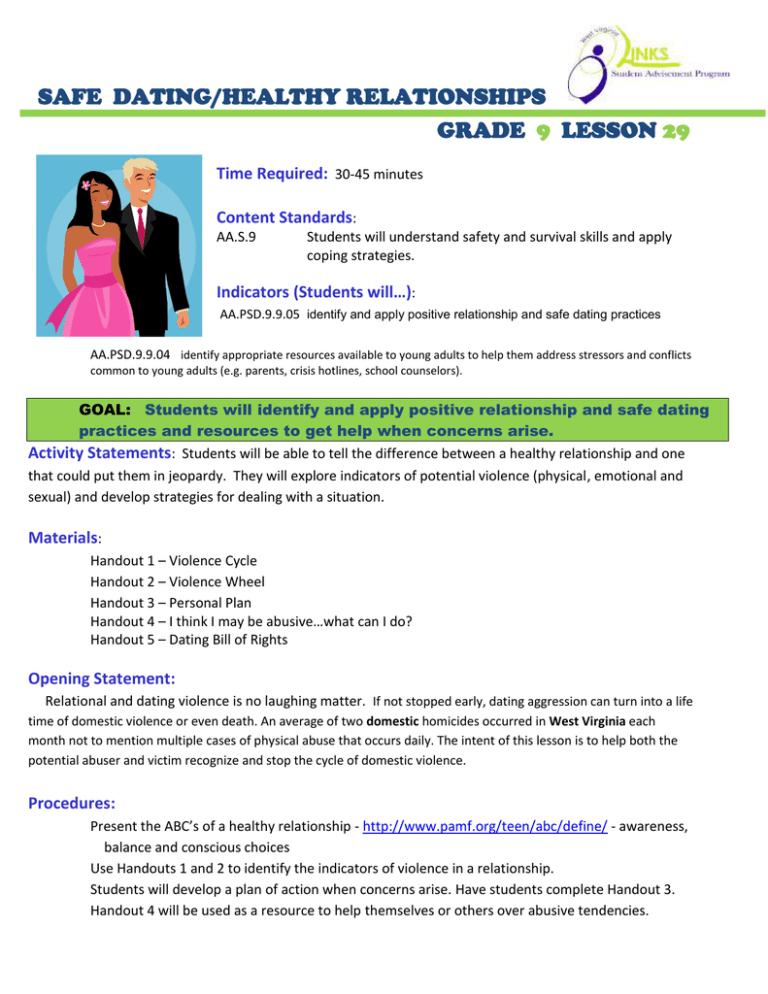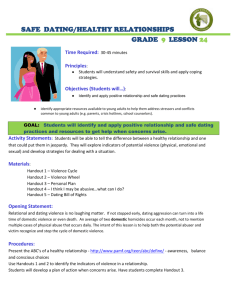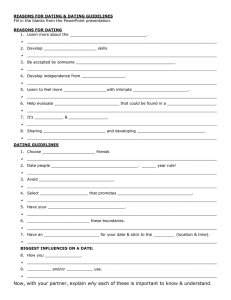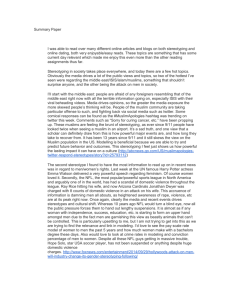SAFE DATING/HEALTHY RELATIONSHIPS GRADE LESSON
advertisement

SAFE DATING/HEALTHY RELATIONSHIPS GRADE 9 LESSON 29 Time Required: 30-45 minutes Content Standards: AA.S.9 Students will understand safety and survival skills and apply coping strategies. Indicators (Students will…): AA.PSD.9.9.05 identify and apply positive relationship and safe dating practices AA.PSD.9.9.04 identify appropriate resources available to young adults to help them address stressors and conflicts common to young adults (e.g. parents, crisis hotlines, school counselors). GOAL: Students will identify and apply positive relationship and safe dating practices and resources to get help when concerns arise. Activity Statements: Students will be able to tell the difference between a healthy relationship and one that could put them in jeopardy. They will explore indicators of potential violence (physical, emotional and sexual) and develop strategies for dealing with a situation. Materials: Handout 1 – Violence Cycle Handout 2 – Violence Wheel Handout 3 – Personal Plan Handout 4 – I think I may be abusive…what can I do? Handout 5 – Dating Bill of Rights Opening Statement: Relational and dating violence is no laughing matter. If not stopped early, dating aggression can turn into a life time of domestic violence or even death. An average of two domestic homicides occurred in West Virginia each month not to mention multiple cases of physical abuse that occurs daily. The intent of this lesson is to help both the potential abuser and victim recognize and stop the cycle of domestic violence. Procedures: Present the ABC’s of a healthy relationship - http://www.pamf.org/teen/abc/define/ - awareness, balance and conscious choices Use Handouts 1 and 2 to identify the indicators of violence in a relationship. Students will develop a plan of action when concerns arise. Have students complete Handout 3. Handout 4 will be used as a resource to help themselves or others over abusive tendencies. SAFE DATING/HEALTHY RELATIONSHIPS GRADE 9 LESSON 29 Divide students in groups and ask them to discuss what they learned from the handouts. Following small group discussion, have group discussion using the following questions as a guide. Instruct students to work independently on a personal plan for dating safely. Instruct students to keep handouts for future reference. Discussion: What behaviors might indicate that you are engaged in an unhealthy relationship? How would you know if the relationship has a problem? If you notice one or more of these indicators in your relationship, what should you do? Where could you go to get help in dealing with a problem? Is possessiveness about control or love? Why or why not? What is the major cause of domestic violence? Name some of your personal rights in a dating relationship Name some of your responsibilities in a relationship What are some rights and responsibilities that weren’t listed? Additional Resources: National Domestic Violence Hotline www.ndvh.org Cycle of Abuse http://www.domesticviolence.org/cycle-of-violence/ Turning Point Services http://www.turningpointservices.org/Domestic%20Violence%20-20Cycle%20of%20Violence.htm WV Coalition Against Domestic Violence (includes WV law) http://www.wvcadv.org Domestic Violence Help Guide http://www.helpguide.org/mental/domestic_violence_abuse_types_signs_causes_effects.htm Dating Violence Guide http://www.acadv.org/dating.html Extension Activities: Recommend to students: Duplicate handouts and share “privately” with friends or family you feel may benefit. Identify the agencies in your area that provide services to individuals who find themselves in an unhealthy or dangerous relationship such as domestic violence centers, family refuge centers, crisis centers and other local support agencies. The list could include school counselors, teachers, family members or other professionals as sources of help. STUDENTS: Fill in the Financial Plans portion of the Post-Secondary Education Plan.





